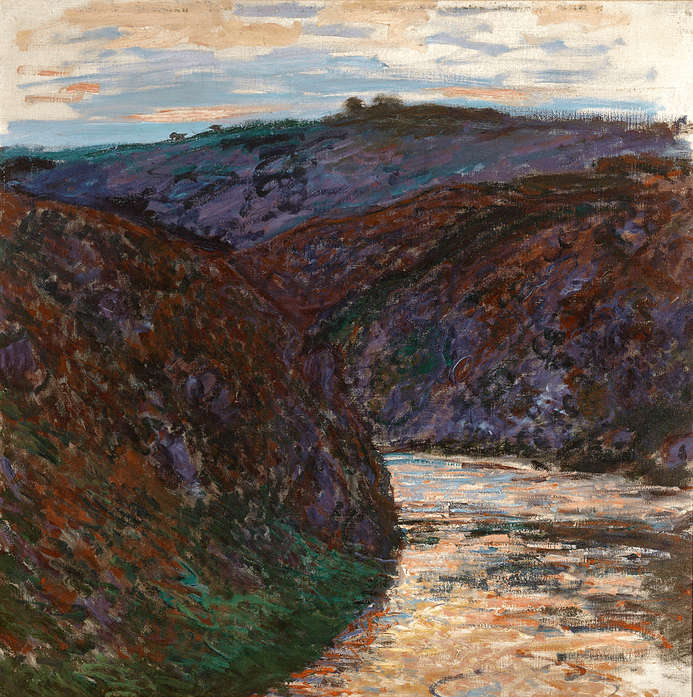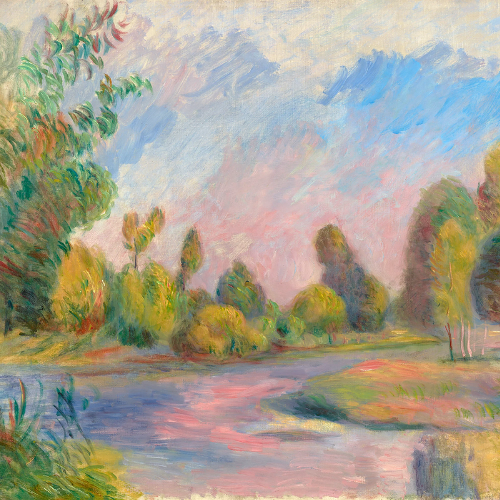We all recognize Claude Monet as the father of Impressionism, one of the most enduring art movements in history. A visionary who was known for prodding at the European art establishment of the late 19th century, he had a hand in changing the entire trajectory of Western Art. His avant-garde style paved the way for modern abstraction, and today, his artworks are blockbusters that have increased in value exponentially and have set records at auction.
So who was Claude Monet and what was his true story? We might think we know everything there is to know about such an enormous cultural figure, but he was a more private and enigmatic person than many realize. Read on to discover some things that might surprise you about one of the world’s most influential artistic minds.
He was born Oscar-Claude Monet, and expectations came with that.
Named for his father Claude-Aldolphe, Monet went by Oscar for much of his young life. The elder Claude had plans for his namesake to join the family grocery business along with his older brother Leon, but Monet instead longed to be an artist. His father was staunchly opposed to this idea, but his mother was more encouraging. She was a lover of the arts and, by all accounts, a lovely singer. After her death when Monet was only 16 years old, his aunt, Marie-Jeanne Lecadre, took him in and was an essential figure in his early development as an artist. An amateur painter herself, she encouraged him to enroll in art school and made it possible financially.
The first works he sold were caricatures.
As a general rule, school was a bore for Monet. He was restless and distracted and he took to doodling in his notebooks, creating irreverent caricatures of his teachers and classmates. By the age of 15, he had gained some local notoriety for these drawings in his coastal town of La Havre for these drawings and began charging 10 to 20 francs a sitting. A local art supply shop even displayed them in their front window. Monet would later be considered among the world's most famous artists for bucking the art establishment of the time, and this was an early indication that he was willing to shake up the status quo. He created over 100 of these drawings, but sadly, only a few survive today.

Caricature of French landscape painter, Jules Didier, by Monet.
He attempted suicide at age 27.
Early in his art career, Monet experienced a great deal of difficulty in selling his work. As mentioned before, his father was not supportive of his chosen profession nor his relationship (he was living with his future wife, Camille Doncieux, out of wedlock), and he had to make his own way. Even his benefactor aunt, Madame Lecadre, had cut him off. In 1868, Monet, Camille, and their newborn son, Jean, were living in poverty in Paris and many of Monet’s paintings were seized by creditors. This fact, plus his extreme frustration with the French art establishment, drove the artist to jump from a bridge into the Seine to drown. Thankfully, the french painter survived and thought of himself as foolish for the attempt. The following day, Monet wrote a letter to friend and fellow artist, Fraderic Bazille, that included a brief account of this episode. The artist wrote, “I was so upset yesterday that I was stupid enough to hurl myself into the water. Fortunately, no harm was done.”
His favorite model was his first wife, Camille.
Monet and Camille were married in 1870 in a civil ceremony with Gustave Courbet as a witness. She appeared in 34 of his compositions from 1865-1879, including some of his most important works such as Camille in Japanese Costume and The Woman in the Green Dress. She not only modeled for her husband, but also for Pierre-August Renoir and Edouard Manet.
Camille fell ill in 1879 and died of pelvic cancer at the young age of 32. Monet painted her till the end, including a haunting portrait of her on her deathbed.
Monet married his second wife, Alice Hoschedé in 1892, although they began a relationship shortly after Camille’s death. She and her six children from her marriage to department store magnate, Ernest Hoschedé, had actually been living with the Monets beginning in 1877 after her husband declared bankruptcy. After Camille’s death, Alice was consumed by jealousy and insisted that Claude destroy almost every picture of her. However, Monet depicted Alice in far fewer paintings than Camille.

The Red Kerchief (Portrait of Madame Monet) by Claude Monet, 1867
He had a “secret” art collection including artworks by some of the greatest artists of his time.
Monet was an avid art collector, but a rather private person and kept his collection largely to himself. The french painter never formally inventoried his collection during his lifetime, but he owned around 120 works that included paintings by Manet, Renoir, Cézanne, Pissarro and Delacroix, and over 20 albums of prints by Japanese artist, Hokusai - a staggeringly impressive lineup. He kept these in his upstairs private apartments of his country house in Giverny and only allowed a very few lucky visitors to view them. It was finally put on public display for the first time at the Marmottan Monet Museum a full ninety years after the artist’s death.
He began collecting while still a struggling young artist with gifts from his painter friends, but eventually had the means to purchase and trade for paintings. Notably, Monet owned four watercolors by Paul Signac, prominent Neo-Impressionist and a developer of the Pointillist style. These acquisitions are notable because they stand in contradiction to Monet’s public statements indicating that he was highly critical of the movement (as were a few other prominent Impressionists such as Manet and Renoir). In fact...
He refused to exhibit alongside Neo-Impressionists.
The Impressionists held eight Impressionist Exhibitions from 1874-1886. The artists organized these as an alternative to the Salon, which represented the French art establishment that shunned their new, avant-garde artistic movement. Participation fluctuated from year to year, but Monet was a fairly consistent member of these exhibitions. Camille Pissarro was the only artist to show in all eight. Pissarro saw great promise in Neo-Impressionists Seurat and Signac, saying their work had an “unusual element” and invited them to be a part of the eighth and final exhibition of 1886. Monet, however, found pointillist figures too rigid and static and did not care to show alongside them in this exhibition, and instead submitted work to the Salon that year, as did Renoir. Pissarro told the Seurat and Signac that he would exhibit with them in the same room at the Impressionist Exhibition, separate from the others, “That way we can arrange the things to suit ourselves.”
He was exacting when it came to his famous gardens.
After purchasing his country house in Giverny in 1890, he began work on one of his proudest accomplishments - his gardens. These gardens were extremely important to his trajectory as an artist, and he would paint them for the rest of his life. They needed to be perfect. He imported plants from South America and Egypt and diverted a nearby river to create a pond. The impressionist painter also employed six workers to tend to his gardens and wrote daily instructions to them. One worker was even a lily pad duster whose job it was to make sure the lily pads were cleaned every morning before Monet began to paint them! His lily paintings are some of his most famous pieces of work today.
Today, Monet’s home and gardens at Giverny are a French national monument and are visited by half a million people each year.

Monet (right) surveys his gardens from his Japanese bridge with an unknown companion in 1922.
His eyesight was failing in his later years.
Monet developed severe cataracts and was pronounced legally blind in 1922. During this time, he was deep within his waterlily series, and the cataracts greatly affected his perception of color, especially on the blue and green spectrum, and many of his lilies from this period take on reddish hues. “Reds looked muddy to me, pinks insipid, and the intermediate or lower notes in the color scale escaped me,” Monet said. But he kept on, developing an organizational system for his paint palette in order to keep his colors straight. He wrote to his friend Marcel Pays in 1921, “As long as my paint tubes and brushes are not mixed up … I will paint almost blind, as Beethoven composed completely deaf.”
He underwent surgery on his right eye in 1923, but never the other, and his waterlilies took on violet and blue hues again. The famous impressionist painter was always hyper-critical of his own work, and he ended up destroying many of his paintings from his vision loss period, however, the ones that survived are considered an important transition between Impressionism and pure abstraction.
Claude Monet had a major impact on the modern art movement and was a key figure in revolutionizing traditional French art in the late 19th century. A true pioneer in the fine arts, Monet's legacy lives on and will always be remembered for his influence on French impressionism and modern art.
Browse our website to explore M.S. Rau’s selection of important fine art, including Impressionist masterpieces by artists like the great Claude Monet. You can also explore original Monet art for sale.
Sources:
Baillo, Joseph. Monet. New York: Abrams, 2010.
Monet, Claude, and William Chapin. Seitz. Claude Monet. New York: Abrams/Easton Press, 1982.
“Monet Employed a Water Lily Duster!” Atavist, February 8, 2016. https://mentalfloss.atavist.com/monet-employed-a-water-lily-duster.
Sagner, Karin, and Claude Monet. Monet. Köln: Taschen, 2006.
Seurat, Georges, and Robert L. Herbert. Georges Seurat 1859-1891 ;New York: Metropolitan Museum, 1991.
Www.dailysabah.com. “Monet's 'Secret' Painting Collection on Display for 1st Time in 90 Years.” DailySabah. www.dailysabah.com, September 14, 2017. https://www.dailysabah.com/arts-culture/2017/09/14/monets-secret-painting-collection-on-display-for-1st-time-in-90-years.










